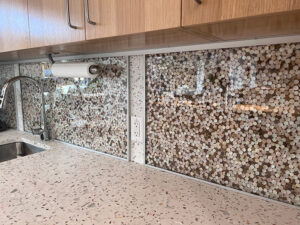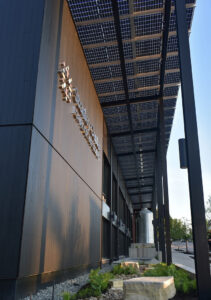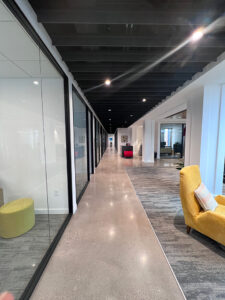LBC Petal – Materials
The Living Building Challenge (LBC) promotes a responsible materials economy: a model that calls for locally-sourced construction materials that are non-toxic and pose little to no impact on humans or the environment. The LBC also nurtures product transparency by requiring materials to be red-list-free.
 Responsible materials are key to a regenerative future and are a large component of the Living Building Challenge. At the Stanley Center, these materials are highlighted on both the inside and the outside of our building. For example, the building’s exterior wall helps to lower our building’s energy demands. This Acoya Rainscreen siding is long-lasting, low maintenance, non-toxic, and 100% recyclable. In our kitchen, we have a recycled glass countertop that was sourced from nearby Chicago. The countertops are created from 85% recycled content and include mother of pearl surfaces to symbolize Muscatine’s pearl button history.
Responsible materials are key to a regenerative future and are a large component of the Living Building Challenge. At the Stanley Center, these materials are highlighted on both the inside and the outside of our building. For example, the building’s exterior wall helps to lower our building’s energy demands. This Acoya Rainscreen siding is long-lasting, low maintenance, non-toxic, and 100% recyclable. In our kitchen, we have a recycled glass countertop that was sourced from nearby Chicago. The countertops are created from 85% recycled content and include mother of pearl surfaces to symbolize Muscatine’s pearl button history.
 To ensure that 90% of the cost of new materials were red-list free, we partnered with Integrated Eco Strategy to access their red-list free materials database. Some of these materials in our building include the felt sound baffles, copper piping, wiring, and the office and conference room walls. HNI Workplace Furnishings in Muscatine pursued a Declare Label to provide transparency into their processes and insight into the red-list free material they included in their modular wall product. Over 140 products in our building have the Declare Label and over 1,700 letters were sent to manufacturers when this labeling was unavailable to advocate for honest and open information sharing.
To ensure that 90% of the cost of new materials were red-list free, we partnered with Integrated Eco Strategy to access their red-list free materials database. Some of these materials in our building include the felt sound baffles, copper piping, wiring, and the office and conference room walls. HNI Workplace Furnishings in Muscatine pursued a Declare Label to provide transparency into their processes and insight into the red-list free material they included in their modular wall product. Over 140 products in our building have the Declare Label and over 1,700 letters were sent to manufacturers when this labeling was unavailable to advocate for honest and open information sharing.
 Part of the material’s petal concerns the proximal sourcing of materials. The Living Building Challenge requires that 20% of the materials we use come from within 500 kilometers of the Stanley Center, 30% within 100 kilometers, and 25% within 5,000 kilometers. Upon completion, we sourced just 9% of our materials from beyond 5,000 kilometers and 48% from within 500 kilometers. Some major items that were locally sourced include concrete, structural steel, roofing, pavers, wood veneers, acoustic baffles, and recycled glass countertops.
Part of the material’s petal concerns the proximal sourcing of materials. The Living Building Challenge requires that 20% of the materials we use come from within 500 kilometers of the Stanley Center, 30% within 100 kilometers, and 25% within 5,000 kilometers. Upon completion, we sourced just 9% of our materials from beyond 5,000 kilometers and 48% from within 500 kilometers. Some major items that were locally sourced include concrete, structural steel, roofing, pavers, wood veneers, acoustic baffles, and recycled glass countertops.
Rather than relying on new materials to build our home, it was important to us that we reuse as much existing material as possible. We were able to reuse or recycle some of the previous library’s insulation, plaster, mesh, commercial glass, drywall, bricks, and more. With the completion of our building, we ended up using more of the existing library materials than new materials with a total of 95% of the previous building mass reused. In the end, we diverted 95.2% of construction and demolition waste from the landfill by recycling, reusing, or repurposing.
Learn more from Neumann Monson Architects about the LBC materials petal, mitigating urban heat islands, and the Tally Life Cycle Assessment.
